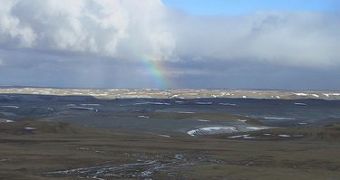The hostile environment of the Haughton Crater on Devon Island in Canada is perfect for simulating tough conditions on other planets. The HMP-2010 began on July 19 and will last for three weeks of technology testing and control of the crew and the mission's activities.
On other planetary bodies, it is extremely useful for astronauts to have robots do tasks that require humans a lot of time, or that are repetitive and not very captivating. As Devon Island is the largest uninhabited island on Earth (66,800 km²) with the easternmost third of the territory covered in ice and sharp sea cliffs, glacial valleys and fjords on its coasts, it is the perfect environment for testing space equipment.
Robots will do most follow-up work in future planet-explorations so NASA crew are testing them, as well as geotechnical instruments, spectrometers or ground-penetrating radars. During this training mission on the Haughton Crater, NASA will test robots made by the Intelligent Robotics Group at Ames. These robots are called K10s and are fully equipped for planet exploring. Their instruments include color imagers, a 3-D scanning Lidar (Light Detector And Ranging), ground-penetrating radar and spectrometers. They are able to map above and below ground, analyzing soil, rocks and key areas landscapes.
“Explorers, such as geologists, often find themselves with a set of observations they would have liked to make, or samples they would have liked to take, if only they had been able to stay longer at a site,” said the director of the Intelligent Robotics Group at NASA's Ames Research Center in Moffett Field, California, Terry Fong. “Our work this year is to study how remotely -operated robots, perhaps even vehicles previously used for crew transport, can be used to perform follow-up work.”
Another crucial element for astronauts is having very precise information about the ground and being able to take auxiliary routes if they encounter unexpected obstacles. Matt Leonard, deputy manager of the Lunar Surface Systems Project (LSS) at NASA's Johnson Space Center in Houston says: “Poor lighting and low resolution of satellite imagery can make a planned route look very simple from above. But once we are on the ground, we can see obstacles we couldn't before that make the route unexpectedly challenging. We will study how to use ground robots to scout alternative safe routes, categorize hard-to-detect obstacles and examine how best to prepare for venturing into unknown terrain.”
During the next two weeks, scientists also have to study how a robot on a pre-established route with a fixed schedule carry on scientific tasks such as gathering images or taking samples. For simulating a planetary crew rover, scientists will work with a K10 robot and HMP's MARS-1 Humvee Rover field exploration vehicle.
Devon Island is located in the Territory of Nunavut in Canada. The expedition base camp is set just outside the northwest area of the Haughton impact crater, which is located at 75°22'N latitude and 89°41'W longitude. This HMP-2010 in Canada prepares both Moon and Mars Analog Mission Activities Program in the Science Mission Directorate and the Exploration Technology Development Program in the Exploration Systems Mission Directorate at NASA Headquarters in Washington. The HMP-2010 project is managed by the Mars Institute in Moffett Field, California, in collaboration with the SETI Institute in Mountain View, California.

 14 DAY TRIAL //
14 DAY TRIAL //